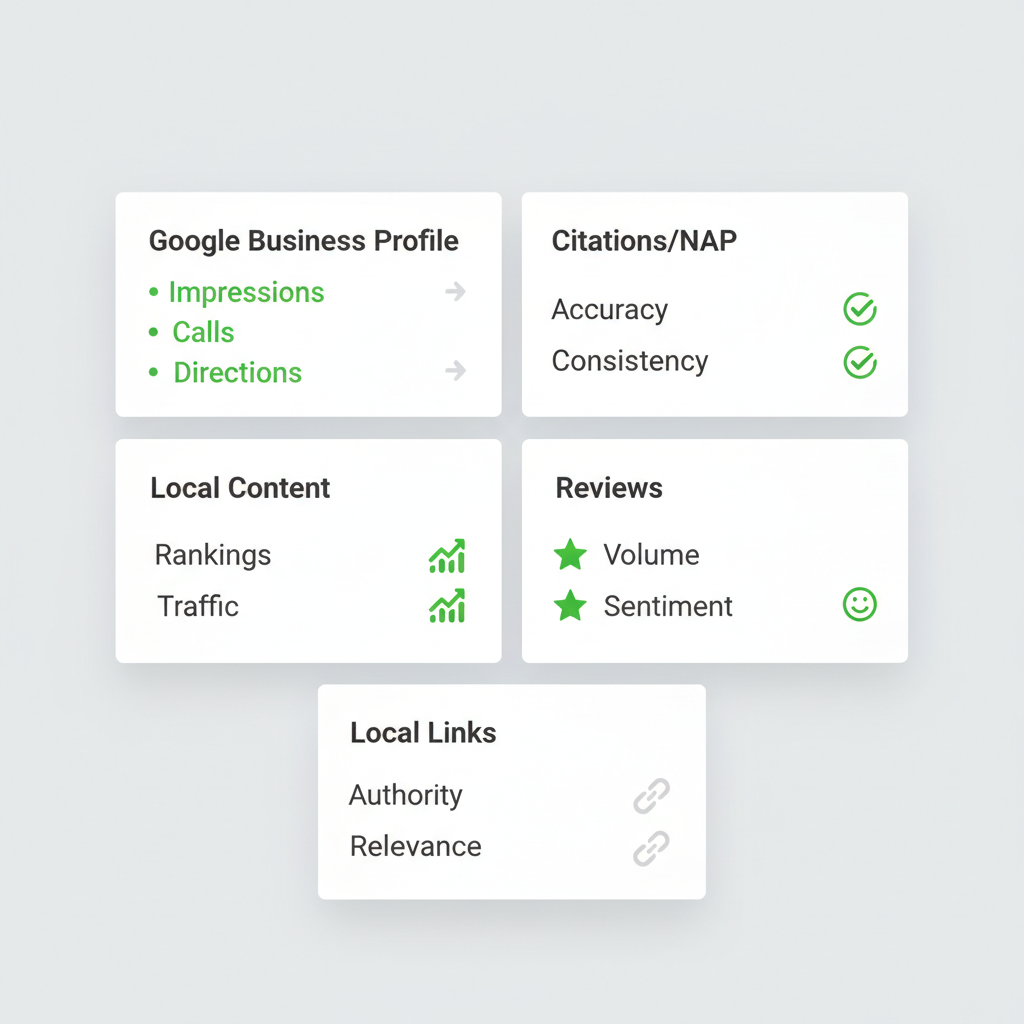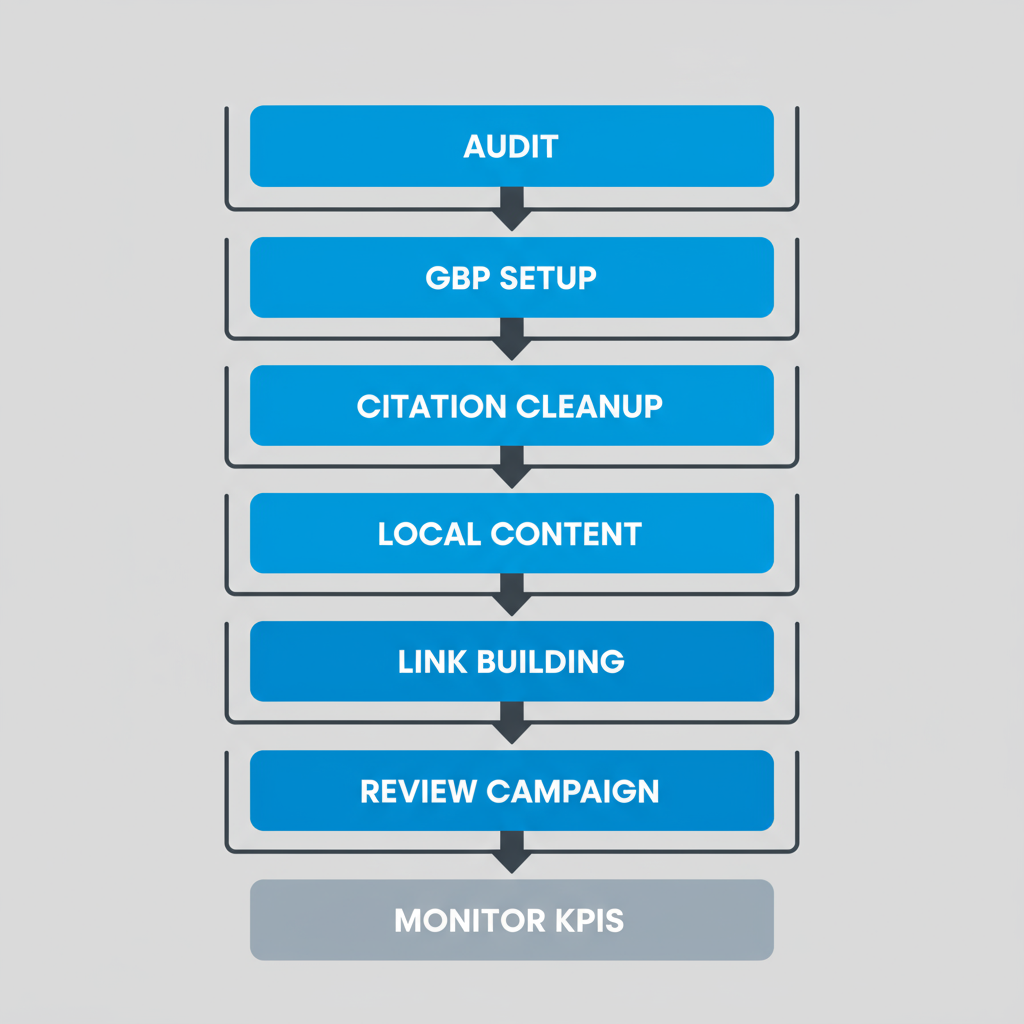- Advanced Local SEO Strategies
- Fundamentals of Local SEO
- Google Business Profile (GBP) Optimization
- Local Keywords and Content Strategy
- Local Link Building
- Local Paid Advertising
- Local Search Ranking Factors
- Local SEO Best Practices
- Local SEO Tools and Analytics
- Local Social Media Marketing
- Online Reviews and Reputation Management
- Technical SEO for Local Businesses
What Is Local Seo Marketing
Table of Contents
Understanding Local SEO Basics
What Local SEO Means
Local SEO marketing outperforms traditional digital advertising for any business that depends on local customer traffic, especially those with a physical presence. It's the focused process of amplifying a business's online visibility in geographic-specific searches across major engines like Google, and it's fundamentally different than broad, national SEO. The primary goal is to dominate results for location-based searches--think "dentist near me" or "best pizza in Miami"--by ensuring your business appears in local map packs, on Google Business Profile (GBP) listings, and high in organic rankings. This approach captures intent-ready buyers at the moment when they're searching for solutions within your catchment area. Ignore this, and you forfeit direct foot traffic to competitors that leverage location targeting. Local Seo Services Miami represent the cutting edge of this movement, utilizing automation and AI to put your brand in front of ready-to-act consumers faster than legacy agencies.
Who Benefits Most
Local SEO delivers a direct competitive advantage to brick-and-mortar retailers, restaurants, law firms, dental clinics, home service companies, and any professional whose revenue depends on physically serving local clients. Professional services--doctors, attorneys, accountants--can dominate highly competitive search real estate at a fraction of the cost of paid ads. Service-area businesses, such as HVAC, plumbing, or cleaning, thrive with geo-targeted rankings that translate to more qualified local bookings. There's no room for debate: local SEO is mission-critical for every business that needs to be found by nearby, intent-driven customers--especially as "near me" smartphone searches now account for more than half of all local queries. Larger national brands may struggle to replicate true local relevance, making this an opportunity for independent and regional players to outpace chains.
How This Guide Helps
This guide breaks down the core principles behind local SEO, outlines a proven workflow for execution, pinpoints what to measure, and provides concrete next steps. Whether you're starting from scratch or trying to outpace entrenched competitors, it's an actionable blueprint for boosting discoverability, in-person visits, and customer conversion in your community.
Core Local SEO Fundamentals
Google Business Profile Basics
No business achieves sustainable local rankings without a fully optimized Google Business Profile. Completing every GBP field--categories, services, hours, photos, and attributes--signals to Google and users that your business is legitimate and active. Always verify your profile, keep information accurate, and update photos and services regularly. Businesses that consistently post new photos, respond to reviews, and update their service lists outperform those that treat GBP as a ‘set it and forget it' task. GBP interactions drive direct conversions: over 90% of users rely on GBP listings to make local purchase decisions, and businesses with robust profiles see click-to-call and direction requests surge.
Local Citations And NAP
Citations are the foundation of local trust. A citation is any mention of your business's Name, Address, and Phone (NAP) across the web--on directories, review sites, or data aggregators. Google trusts what it can cross-reference; inconsistent or incorrect NAP data undermines your authority and buries results. Use data aggregators for breadth and correct industry lists for depth, but never compromise accuracy. Businesses with flawless NAP consistency rise above local competitors nearly every time.
Local Content And Keywords
To crush local SEO, build content around location-specific queries: neighborhoods, landmarks, and unique local services. Identify the keywords real customers are searching, not just generic "best + service" phrases. Integrating geo-modified keywords throughout onsite pages, meta descriptions, and blog content increases relevance for both ‘near me' and broader city searches. Original, user-focused content with local context routinely outperforms generic copy, driving higher relevance scores with search engines.
Reviews And Reputation
Businesses that win the review game dominate local rankings and customer trust. Encourage every satisfied customer to leave a review on Google and credible third-party sites. Respond to all feedback, good or bad, showing prospective clients real engagement. Review volume directly influences your prominence in map packs. Even a one-star difference can drive a 22% pricing premium for local services--proof that reputation is the new currency of local business.
Local Links Overview
Google's algorithm rewards businesses embedded in the local ecosystem. Backlinks from local news outlets, chamber of commerce pages, nonprofits, and respected local blogs carry far more weight than generic directory listings. Strategic sponsorships, business partnerships, and features in community roundups create authority that can't be purchased on global link farms. Fewer, higher quality links always eclipse a high volume of irrelevant links for local search performance.

Understanding the five core local SEO fundamentals and their impact on business growth.
Comparison Table: Local Citation Sources Compared
| Source Type | Reliability | SEO Value | Notes |
|---|---|---|---|
| Local Directories | Medium-High | Medium - helps verification/local context | Prioritize authoritative directories/chamber. |
| Industry Lists | Medium | Medium-High | Focus on relevancy and niche accuracy. |
| Data Aggregators | High | High - affects many downstream listings | Use for scale and distribution breadth. |
How Local SEO Works
Ranking Signals For Local SEO
Successful local SEO isn't a black box of secrets. Google prioritizes three signals: proximity, relevance, and prominence. Proximity measures user distance to your business, relevance is the match between services and search intent, and prominence signals authority based on reviews, backlinks, and trustworthy citations. Optimizing your GBP, consistent NAP, acquiring authoritative local links, and growing a steady review profile skyrocket local rankings--even if your site is newer or less established than legacy competitors.
How Search Engines Determine Local Relevance
Search engines parse every digital clue to match businesses with local search intent. They scan GBP listings, scour on-site content for geo-keywords, and verify data through consistent online citations. Frequent review activity, rich media content, and detailed service descriptions all increase your "local relevance" score. Inconsistency in these areas acts as friction, preventing your company from surfacing in top results.
"Near Me" Search Mechanics
"Near me" searches have fundamentally changed user behavior. Over 90% of consumers searching on smartphones expect immediate, hyperlocal results. Google's local algorithms factor device location, query intent, and business proximity in real-time--no manual input required. If your GBP and website aren't optimized for these signals, your competitors collect the lion's share of high-converting, ready-to-buy customers. Capture ‘near me' queries by ensuring your business details and category coverage match local demand patterns--results move in days, not months, with tightly executed local SEO.
Local Pack vs Organic Results
The local pack (map results) dominates above-the-fold visibility for transactional queries. Businesses appearing here see exponentially higher click and call-through rates than organic-only rankings. Local pack inclusion relies on GBP optimization, reviews, and proximity, while organic requires deep onsite content and high authority backlinks. The conversion rate for map listings regularly outperforms organic by two to three times: local intent means action, not just research.
Comparison Table: Local Pack Versus Organic Listings
| Result Type | Primary Intent | Main Ranking Factors | Expected Conversion |
|---|---|---|---|
| Local Pack | Transactional/Local | GBP, proximity, reviews | High - calls/directions |
| Organic Listing | Informational/Transactional | On-page, backlinks | Medium - visits, form fills |
| Local Finder | Local Research | GBP, review volume | Medium-High - research/visits |
Local SEO Implementation Workflow

Step-by-step local SEO implementation workflow for optimized search visibility.
Step-By-Step Implementation Workflow
Best-in-class local SEO follows a relentless, repeatable process:
- Perform a technical audit (site speed, mobile-readiness, crawlability)
- Configure and optimize Google Business Profile (fully verify, set categories, services, hours)
- Scrub and unify all citations/NAP--including aggregators and directories
- Create locally focused landing pages and blog content
- Build high-quality local backlinks through community partnerships
- Launch review campaigns and respond to every submission
- Monitor KPIs with structured dashboards--watch rankings, clicks, calls, and direction requests
Businesses sticking to this sequence pull ahead within 30-60 days, even in saturated markets. Best Local Seo Services Miami FL are built around this workflow--there's no need to reinvent the wheel.
Optimizing Google Business Profile
Leave nothing blank. Prioritize category precision, upload real photos, update hours, and post offers or updates weekly. Add service menus, booking links, and highlight special amenities. Profiles maximizing detail routinely see double the engagement versus incomplete competitors. Regular optimization also helps counter negative reviews and incorrect information propagated by third-party sites.
Building Citations And Links
Don't chase every directory; prioritize quality and relevance. Focus first on industry-leading directories, authoritative local lists, and trusted data aggregators for bulk citation distribution. For backlinks, build relationships with local journalists, community event organizers, or partner businesses--every real-world connection can become an SEO asset if leveraged correctly.
Monitoring And Metrics
Ignore vanity metrics. The only numbers that matter: local impressions, user actions on GBP (calls, direction requests), website click-through rate, review growth, and conversion rate from search. Use real-time dashboards, not outdated static reports, to drive decisions. SEOLocal Miami's reporting model--transparent, immediate, and focused on ROI--should be the new standard. If you can't measure progress weekly, your campaign is already behind.
Table: Local SEO Implementation Checklist
| Activity | Estimated Effort | Priority | Impact |
|---|---|---|---|
| GBP Claim & Setup | 1-2 hours | Critical | Immediate visibility boost |
| Citation Cleanup | 3-6 hours | High | Improves trust/local rankings |
| Review Campaign | Ongoing | High | Increases conversion/prominence |
Advanced Local SEO Strategies
Advanced Schema And Structured Data
Elevate your rankings with advanced schema--LocalBusiness, geo, and structured reviews. Structured data ensures search engines parse your business attributes, triggering enhanced snippets, rich map results, and event highlights. Only 35% of local businesses implement true schema; the rest leave easy rankings on the table. Unstructured data is an invitation to invisibility.
Local Content Strategies
Dominate competitors by developing hyperlocal content: detailed neighborhood guides, event recaps, customer features, and in-depth service pages. Google rewards sites that prove geographical expertise--not just keywords, but authentic, contextual relevance. Businesses deploying event calendars, resource directories, and service-area landing pages enjoy compounding local ranking advantages.
Managing Multi-Location SEO
Scaling across locations works only when each profile and page is locally unique--centralized templates destroy authenticity. Use per-location pages with distinct content, reviews, and NAP info to prevent cannibalization. Multi-location dashboards streamline duplicate checks and citation management, but organizational discipline is non-negotiable for sustainable growth.
Table: Multi-Location Strategy Options
| Strategy | Pros | Cons | Best For |
|---|---|---|---|
| Centralized Pages | Easy, consolidated authority | Can dilute local signals | Businesses in close-knit areas |
| Per-Location Pages | Strongest local relevance | Higher content workload | Chains with distinct branches |
| Separate Microsites | Highly localized control | High maintenance | Independent operating locations |
Common Local SEO Questions
How Does Local Differ From Traditional?
Local SEO obsesses over proximity and user intent--traditional SEO ignores the map and local queries. GBP management, citation consistency, and review cultivation are pointless in pure national SEO. If you aren't optimizing for local triggers, you'll never own the customer at the moment of need.
Why Local SEO Matters
Local search determines who gets discovered and who is invisible. Businesses leading in local SEO see higher foot traffic, more bookings, and measurable sales lift. The data is irrefutable: optimization equates to real revenue.
Quick Start Checklist
Start by claiming your Google Business Profile, aligning all citations, and requesting reviews. Then, build locally relevant content. For details, grab the Local SEO Checklist--waiting costs market share.
Getting Started With Local SEO
Actionable Next Steps
Claim your GBP, standardize your citations, activate a review campaign, and write location-rich service content. Each item delivers compounding benefits--neglect one, and results stall.
When To Get Help
When you need results faster than DIY can deliver or face multi-location complexity, bring in specialists. Local seo services with automation and managed support eliminate guesswork and deliver measurable outcomes even in the most saturated markets. The risk isn't over-investment in SEO--it's failing to act until competitors already own your neighborhood.






